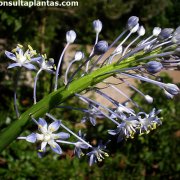Care of the bulbous plant Scilla natalensis or Blue Scilla |
|
The genus Scilla, family Asparagaceae, comprises 90 species of bulbous plants native to Asia, Africa and Europe. Some species are: Scilla natalensis, Scilla latifolia, Scilla obtusifolia, Scilla bifolia, Scilla autumnalis, Scilla lanceolata, Scilla italica, Scilla lanceolata, Scilla peruviana, Scilla sibirica, Scilla odorata. Common names: Blue Scilla, Wild squill, Blue hyacinth, Blue squill. This species is native to Southern Africa. They are bulbous plants with a large bulb up to 15 cm (5.9") in diameter that reach 1 meter (3.28 feet) in height when they bloom. The leaves are deciduous, light green in color and may have whitish or purple spots; they reach 50 cm (19.68") in length; in late summer they begin to turn yellow until dry. The attractive terminal clusters are filled with small starry flowers, scented with honey and colored blue or white. They bloom in spring and early summer. Blue Scilla is used in rockeries, on borders, on slopes, in pots and planters and as cut flowers for floral decorations and bouquets. It's a toxic plant if any of its parts are ingested. Scilla natalensis can grow in direct sunlight or semi-shade exposures. It resists occasional frosts down to -6 ºC (21.2 ºF). The soil can be a mixture of 1/3 garden soil, 1/3 coarse sand, and 1/3 compost. Wild squill can be transplanted at any time of the year. The bulbs are sown in late winter with 2/3 of the bulb above the ground. Blue hyacinth resists several days of drought but in summer it appreciates regular waterings waiting for the soil to have dried. From autumn reduce watering and do not water in winter. Fertilize with compost or manure in late winter and slow-release mineral fertilizer once in spring and again in early summer. Blue Scilla does not need pruning but bulbs can be removed from the ground in late fall if winter is too cold and replanted in late winter. Scilla natalensis does not usually present serious pest and disease problems. Blue squill is propagated from the bulblets produced by the mother plant or by seeds sown in autumn; the seeds germinate in a week but they do not maintain their germinative power for long if they are not kept refrigerated. |
Images of the bulbous plant Scilla natalensis or Blue Scilla |
Find plants
Scilla natalensis or Blue Scilla | Care and Growing
© 2025 FavThemes

